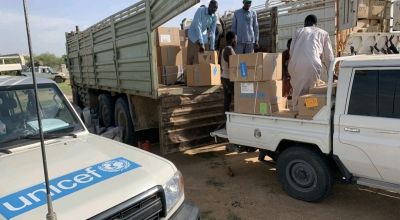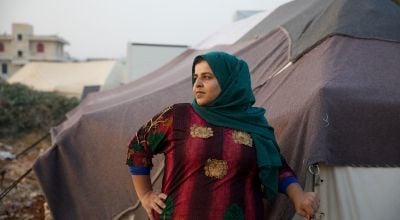
Read our 2022 annual report

Knowledge Hub
More than six months into the crisis, here's what you need to know.
Since October 2023, a massive humanitarian crisis has been spiralling out of control in Gaza, destroying homes, infrastructure, families, and lives.
Gaza’s recent history of conflict escalated on 7th October 2023, when an unprecedented attack on Israel left 1,200 people dead and an additional 253 others taken to Gaza as hostages. (Some hostages have been released since then, others killed, and Israel estimates 133 remain in Gaza.) Since then, heavy fighting and bombardment have caused an estimated 34,000 deaths and 77,000 injuries to date and have led to one of the world’s worst humanitarian, displacement, and hunger crises.
More than six months on, here’s what you need to know about the humanitarian situation in Gaza — and what Concern is doing to help.
1. Humanitarian need in Gaza is basically at 100%
The Integrated Food Security Phase Classification (IPC) has reported that over six months of conflict have left the entire population of the Gaza Strip — approximately 2.23 million people — facing urgent humanitarian needs, including food and nutrition support, medical assistance, and water, sanitation, and hygiene (WASH) services.
Limited humanitarian access throughout Gaza, particularly in the northern areas, continues to exacerbate the catastrophic levels of food insecurity already faced by people and prevent the urgent delivery of life-saving nutrition supplies.

2. Even before the current escalation, about 80% of the population of Gaza was in need of humanitarian assistance
There was already a high level of humanitarian need in Gaza before October 2023, with the UN Conference on Trade and Development reporting that 80% of Gazans depended on international aid in 2022. While unemployment was high across the Occupied Palestinian Territories, the rates in Gaza were more than three times as high as those in the West Bank (45% compared to 13%), with women and youth hit hardest by poverty, which affected 65% of all Gazans.
Prior to October 2023, an estimated 500 aid trucks crossed into Gaza daily. In the weeks following the 7 October attacks, that flow was all but completely halted, with the UN reporting an average of 12 trucks per day entering the territory at the end of October. At the same time, needs were becoming far greater than any time before, both in terms of severity of need and the number of people affected. In nearly the whole month of March, only 350 trucks were able to cross into Gaza. We are now at an estimated 100 trucks per day reaching the northern half of the Gaza Strip through two main crossing points. However, the aid being delivered still falls far short of the level needed to address even the most acute needs.

3. Approximately 85% of Gazans are displaced
Roughly 1.9 million Gazans (85% of the population) have been displaced over the last six months. Many people have relocated multiple times — a fact that makes it harder to address issues like the rising number of malnutrition cases (more on that below). As the conflict wears on, Gazans are also finding fewer options for shelter, concentrating into an increasingly smaller geographic area. Approximately 1.15 million Gazans — half of the Strip’s population — are currently sheltering in Rafah, the southernmost governorate and roughly the size of Limerick city.
While currently safer than other parts of the Strip, there are growing concerns that Rafah may soon face a full-scale ground operation. Amid this, civilians also face extreme challenges in accessing water, sanitation facilities, and basic healthcare. On 28 April, Gaza’s Coastal Municipalities Water Utility reported that the governorate’s entire water and sanitation system was nearing collapse amid damage to infrastructure, electricity supply cuts, and fuel shortages.

4. Half of Gaza is facing an imminent famine
The cumulative effects of the ongoing violence, multiple displacements, restrictions on humanitarian access, and the destruction of infrastructure have led to what the Food and Agriculture Organisation has deemed a total collapse of all food-related sectors in Gaza, including vegetable production, livestock production, and fisheries. This has left the entire population of Gaza — all 2.23 million — facing high levels of acute food insecurity.
The IPC’s December 2023 analysis of Gaza warned that famine might occur by the end of May unless there was an immediate cessation of hostilities and sustained civilian access to essential supplies and services. Those conditions have not been met, meaning that half of all Gazans are now facing famine. The hunger levels are highest in the northern governorates, where famine is projected as “imminent”, meaning that it may occur any time between now and the end of the month. The IPC reports that, in two-thirds of the households in this region, people went without food for an entire 24-hour period at least ten times in the last 30 days. In the southern governorates, such as Deir al-Balah, Khan Younis, and Rafah, a worst-case scenario would see a famine taking place before July.
“If no steps are taken to cease hostilities and to provide more humanitarian access, famine is imminent, it could already be occurring,” says FAO’s Deputy Director-General Beth Bechdol. “Immediate access is needed to facilitate delivery of urgent and critical assistance at scale.”

5. Gaza is the most dangerous place to be a child
As UNICEF spokesperson James Elder said in Geneva last December, “The Gaza Strip is the most dangerous place in the world to be a child. And day after day, that brutal reality is reinforced.” Latest statistics show that every ten minutes, one child is killed or injured in Gaza.
The hunger crisis in Gaza has also disproportionately affected children, with over 50,400 children under the age of five estimated to be acutely malnourished. These rates are especially high in the north, where the FAO reports that one out of three children under the age of two is acutely malnourished. Children face additional health risks as the sewage and water systems collapse, compromising the safety of water and increasing the risk of waterborne diseases like diarrhoea and cholera. With their immune systems severely compromised by malnutrition and the healthcare system severely compromised by fighting, children will be more susceptible to these diseases, and face more challenges in recovering. Meanwhile, all children remain exposed to the psychological effects of war, with UNICEF estimating that 100% of all children in Gaza require mental health or psychosocial support.

The crisis in Gaza: Concern’s response
Concern does not have a formal programme in the Occupied Palestinian Territories or Israel. However, the humanitarian crisis in Gaza has escalated to such catastrophic levels that Concern is compelled to respond. Concern will be working with our established partner organisation, CESVI, to deliver lifesaving aid — including nutrition support, water, sanitation, and hygiene (WASH) interventions, and the delivery of essential non-food items — to Gaza. Our initial focus will be on meeting the highest needs in the Rafah and Deir al-Balah governorates.
Last month alone, CESVI delivered 19 tonnes of life-saving ready-to-use therapeutic food (RUTF) to seven clinics in Rafah, with the goal of expanding these services to Deir al-Balah and delivering seven additional tonnes of RUTF. This would help treat an additional 800-900 children over the next four months.
On the WASH front, we are working with our partner to truck in water, as well as essential hygiene kits (including feminine hygiene kits), to four communities in the region, providing over 13,000 gallons of water every day for at least 52 days. With our support, CESVI is also aiming to deliver at least 210 water containers to schools and other facilities housing displaced Gazans, which would ensure clean and safe water access to an additional 1,200 families.





